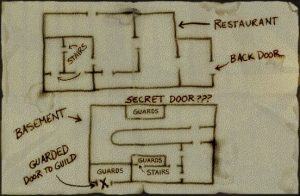Last time I was talking about giving an XP bonus to players who write session reports to encourage them to keep other players who weren’t present up to date with the campaign. Another important aspect of tracking important information that other players will know is the making of maps.
I am not a fan of miniatures in RPGs as I find them to get players into a chess game mode in which they think mostly about moving pieces around and less of actual people and monsters being in wondrous place. (One of the big reasons I quit d20 games.) But when playing online, and especially with changing groups and many people who aren’t native English speakers (or speak quite different variants of English) I find having a map that shows the layout of the area and the position of characters a necessity. It just would get too confusing.
I did make some huge dungeon maps for roll20 using lots of different textures and adding light effects, but while these provide some nice visual cues about the environment it still feels a lot like a miniature game. And from a practical perspective making these maps is a huge pain in the ass. I think in a sandbox game where preparation of dungeons will often happen just between sessions,it just won’t be possible to use such a work intensive method. Last summer I experimented with making premade tiles drawn in the style of Dyson Logos, but that also turned out really fiddly and again you’re drawing attention to the map. So I think what I’ll be doing instead is using simple sketches of black lines that indicate where walls and floor obstacles are and not attempt to show any details on the map. Players will have to remember the description of the room to know what objects they could make use of. But instead of the ugly plain white background of Roll 20 I will try to find some nice parchment or stone face textures onto which the floor plans will be scribbled.

Also, I will disable the square grid. When you knew nothing but d20 games for twelve years it might seem an obvious necessity, but I don’t think even in those a grid is really needed. If you really need to know exactly the distance a character can move in roll20 you can just use the ruler tool and don’t need to count squares. I think using a grid is a big factor that makes players eyes glued to the map and think of combat as a math problem and it’s one that is easily removed.
Now a fun sounding element in oldschool dungeon crawls is players making their own maps as they are progressing through a dungeon, which might be not too accurate. And when the party loses the map or has to flee taking a shortcut through unmapped terrain based on what they assume their current path is leading them back to should be quite exciting. But if you upload a regular dungeon map into roll20, there is no need for the players to make maps, unless you are always covering the map up again when the players move on to the next area. Which doesn’t really seem ideal. I think what might be a good approach is to do what old videogames did and cut the whole map into small areas divided by doors. When the party moves through a door the view changes to a different map. Roll20 can do that without real problem. As the GM you keep a complete map of the dungeon level with clear identification of each area so you always know which map you have to make visible to the players. The only problem is when fights happen to move between areas. But with a simple sketch map you should be able to just draw a few lines that show the rooms beyond the edge of the current map without it looking completely crappy.
A while back the Angry GM wrote about a nice system to make mapmaking not a chore for the players while still keeping the dungeon layout and architecture interesting. At it’s core it comes down to each area having only one exit in each direction and no branching paths unless the intersection is its own separate area on the map. This way the players really only need to make an annotated flowchart of which doors connect to which areas. This is many times simpler and more convenient than having the players translate verbal descriptions of measurements and directions into squares on a grid.
The biggest practical challenge is that the players would not be able to just give the map they made to someone else. This requires scanning or photographing the scribbled map,uploading it,and then sharing the link with the other players. Though by this point this isn’t a huge obstacle anymore. However, if other players are to continue the mapping they still have to transfer the whole map from the image to their own paper. I think this should be managable.
But how do you get players to diligently upload their map after each game so the party can still use it if the player isn’t there the next time? I think I just use the same incentive again: +10% XP bonus for every player who does. Just like writin reports of their expeditions, drawing maps is part of the explorer’s profession. Some very engaged players might regularly get a +20% boost, but using the B/X level progression this is still not going to give them much of a noticeable advantage over other players.
